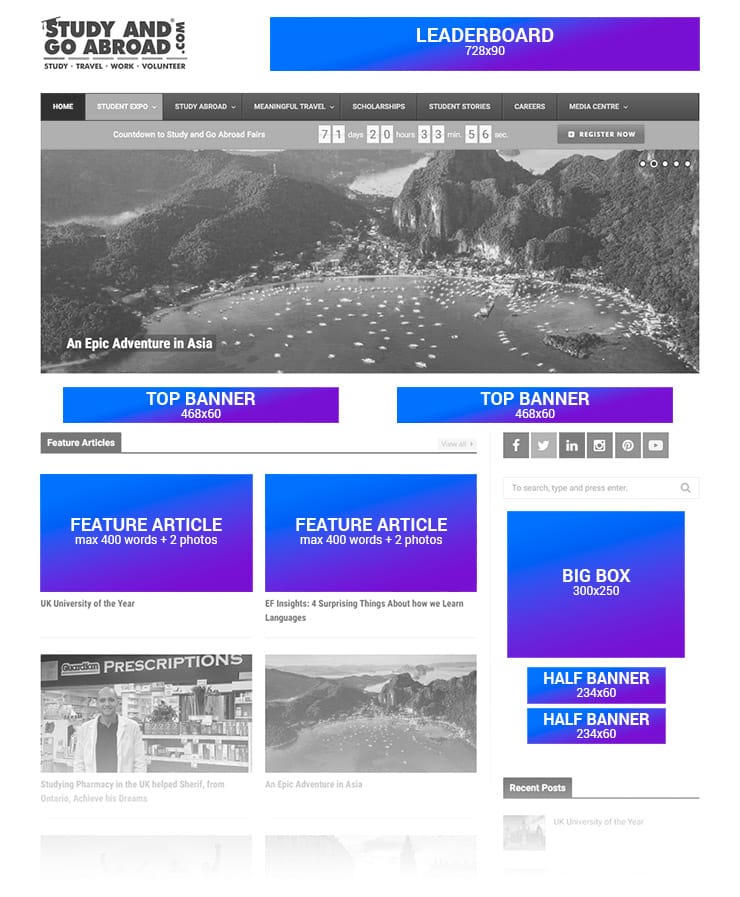Looking across the southern border, you will find more than 4,700 college and university choices in the United States. While the process of applying to U.S. institutions is different, it doesn’t have to be daunting. In fact, a U.S. education is more accessible than you might think.
Number of options
Did I hear right? 4,700?? The United States boasts an incredibly diverse education system with 2-year colleges, public and private universities, liberal arts colleges, research universities, technical and art institutes, specialized universities (such as culinary, fashion, health, or criminal justice), and more! Schools can be as large as 70,000 students and as small as 100 students. You can go to school in the heart of a city or in a remote forest. There is a type, size, and location that fits everyone’s needs!
There are also universities in the United States with special missions, lending to the diversity of how academics are taught and how students experience campus life. There are religious institutions in the Christian, Catholic, Jewish, and Mormon faiths; single-gender colleges; and minority-serving institutions. Historically Black Universities and Colleges (HBCUs) hold a unique place in American history and continue to prioritize black-centered education and campus culture.
Application process
More than 950 U.S. institutions use the Common Application, meaning you will complete basic information about yourself once, and then send it to each college or university you are applying to. While the most selective universities may require additional supplements, essays, letters of recommendation, and interviews, most U.S. universities only require an application, your transcripts, and one admissions essay.
Since COVID-19, it has become even more straightforward to apply to U.S. universities, as many have removed their requirement to submit SAT or ACT scores. More than 60% of U.S. universities have adopted a “test-optional” policy. This means you can choose whether you would like to take and submit a standardized test. This allows students to forgo standardized testing altogether if they so choose.
Cost
Just like the number of college and university options, the cost can range incredibly across U.S. higher education institutions. Tuition can be as low as $0 (there are four work colleges that are free for all students) and as high as $65,000 USD per year. But don’t let that sticker price scare you. The most expensive U.S. universities also tend to be the most generous. Students rarely pay the full sticker price. Sixty-three universities, including the Ivy League, meet an international student’s full financial need, making these expensive-seeming universities actually the most affordable.
You can also save a good deal on tuition by starting at a 2-year college. Typically called community colleges or junior colleges, students can pay less than $10,000 USD per year in tuition for two years and then transfer to a university to complete their final two years. Starting at a community college can greatly reduce tuition and will still have you on track to complete university studies in four years!
How do I get started?
Reach out to EducationUSA, the official source of U.S. higher education. EducationUSA is a free advising service that can help you narrow your search, understand financial aid options, and apply to your top choice universities and colleges.
Visit the EducationUSA College Fair in a city near you (May 9-13) and meet 50+ U.S. universities and colleges.








Discussion18 Comments
Hi, Great article!
This was something I was looking for, really helpful, and great work done. Keep on sharing great content like this.
Maintain the distribution of high-quality information such as this. free games
Check this link https://onlineessaywritingservice.review/reviews/domyessay-review if you wanna know about a reliable essay mill. You won’t have bouts of anger when writing your essays because now you can delegate them to experts from Domyessay.
Thank you for sharing this insightful and informative blog post. The information you provided was relevant and up-to-date. To delve deeper into this topic, click here.
As a person who studies in the US for more than 5 years, I can say that it’s totally worth it. Of course. some institutions are pricey but the quality of education and amount of knowledge you’ll get there is at the top level. I was a nursing student and well, nursing school is like a demanding puzzle that tests our critical thinking skills and resilience. With a nursing sample https://www.nursingpaper.com/examples/medicine/ as our study companion, we can piece together perfect essays that showcase our understanding of this noble profession. It really helped me to deal with all my writing. In addition to all of the above, the campuses and student hotels in the US are amazing, you won’t regret applying there!
I am grateful that you shared this interesting and enlightening blog article with me. Your response included information that was both pertinent and up to date.
So many reasons to study in the United States, including access to top-ranked universities, diverse academic programs, opportunities for research and internships, and exposure to American culture and language.
Usa is a country where is dreams of many people.
Greetings, dear friends! I find myself in a situation where I have a major report deadline approaching, but I’m struggling with the writing process. I’m reaching out to you for any advice or strategies to make this task more manageable. If you have any recommendations or know of useful resources, please share them. Your support would be invaluable!
I’ve been searching for a reliable academic writing service, and I stumbled upon this site. Has anyone tried their services? I’m interested to know if this is a trustworthy platform for buying college papers. They have a wide selection, but I want to hear about people’s experiences. Any insights would be greatly appreciated!
Hello, everyone! I’m currently facing a daunting task of writing a massive report with a looming deadline. I’m feeling lost and in need of urgent assistance. If anyone has any tips or resources that can help me complete this report faster and more efficiently, I would greatly appreciate your guidance.
The accuracy and logical flow of accounting assignments are paramount. Accounting homework writing services prioritize assignment https://www.lunwenhelp.com/assignment-daixie/ quality by conducting rigorous reviews and proofreading, ensuring assignments are error-free and flawless. This not only helps students secure high grades but also provides them with an opportunity for academic improvement.
International students often face tight deadlines, with assignment due dates looming. Accounting homework writing services can deliver high-quality assignments on time from https://www.lunwenhelp.com/essay-daixie/ , ensuring students can submit their work promptly and avoid penalties for late submissions.
Thanks for this wonderful post, we are also delighted to offer you Flex Path Writing Services. Feel free to check https://www.flexpathexperts.com/
Thanks for this wonderful post, we are also delighted to offer you Flex Path Writing Services. Feel free to check https://www.flexpathexperts.com/
Studying in the United States offers numerous benefits, including access to world-renowned universities, diverse academic programs, and a rich cultural experience. The U.S. education system is known for its emphasis on research, innovation, and practical skills, providing students with valuable opportunities for personal and professional growth.
Studying in the United States opens up opportunities for learning and experiencing diverse cultures. Just like in the game Slope Unblocked, where you need quick thinking and determination to overcome obstacles, studying in the United States also requires you to be flexible and persistent to achieve success in a dynamic learning environment.
Study in the United States and master your path to success. Just like navigating through challenges in slope unblocked, education here offers thrilling adventures and rewarding outcomes.